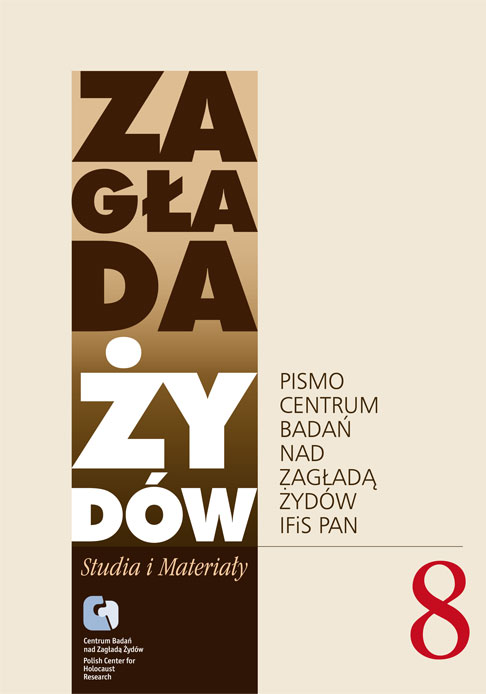O tym, co minęło, lecz nie zostało zapomniane: Badania archeologiczne na terenie byłego obozu zagłady w Treblince
Zagłada Żydów. Studia i Materiały, Nr 8 (2012), Strony: 83-118
Data zgłoszenia: 2020-10-27Data publikacji: 2012-12-02
 https://doi.org/10.32927/ZZSiM.628
https://doi.org/10.32927/ZZSiM.628
Abstrakt
Public impression of the Holocaust is unquestionably centred on knowledge about, and the image of, Auschwitz-Birkenau – the gas chambers, the crematoria, the systematic and industrialized killing of victims. Conversely, knowledge of the former extermination camp at Treblinka, which stands in stark contrast in terms of the visible evidence that survives pertaining to it, is less embedded in general public consciousness. As this paper argues, the contrasting level of knowledge about Auschwitz- Birkenau and Treblinka is centred upon the belief that physical evidence of the camps only survives when it is visible and above-ground. The perception of Treblinka as having been “destroyed” by the Nazis, and the belief that the bodies of all of the victims were cremated without trace, has resulted in a lack of investigation aimed at answering questions about the extent and nature of the camp, and the locations of mass graves and cremation pits. This paper discusses the evidence that demonstrates that traces of the camp do survive. It outlines how archival research and non-invasive archaeological survey has been used to re-evaluate the physical evidence pertaining to Treblinka in a way that respects Jewish Halacha Law. As well as facilitating spatial and temporal analysis of the former extermination camp, this survey has also revealed information about the cultural memory.
Słowa kluczowe
Treblinka , archeologia Zagłady , obóz zagłady , dowody rzeczowe , halacha
Licencja
Prawa autorskie (c) 2012 Autor&"Zagłada Żydów. Studia i Materiały"

Utwór dostępny jest na licencji Creative Commons Uznanie autorstwa 4.0 Międzynarodowe.
https://creativecommons.org/licenses/by/4.0
Czasopismo publikowane jest w standardzie Diamond Open Access na licencji CC-BY-4.0 Deed - Uznanie autorstwa 4.0 Międzynarodowa - Creative Commons
Inne teksty tego samego autora
- Caroline Sturdy Colls, Gone but not Forgotten: Archaeological approaches to the site of the former Treblinka Extermination Camp in Poland , Zagłada Żydów. Studia i Materiały: Nr Holocaust Studies and Materials (2013)
Podobne artykuły
- Helena Datner, Wiedza nieumiejscowiona: Jak (nie) uczyć o Zagładzie w XXI wieku? Recenzja: Wiedza (nie)umiejscowiona. Jak uczyć o Zagładzie w Polsce w XXI wieku?, wstęp i red. Katarzyna Liszka, Kraków: Universitas, 2021, 302 s. , Zagłada Żydów. Studia i Materiały: Nr 18 (2022)
- Sylwia Szymańska-Smolkin, Recenzja: Avihu Ronen, Skazana na życie. Dzienniki i życie Chajki Klinger, tłum. Michał Sobelman, Warszawa: Żydowski Instytut Historyczny, 2021, 1020 s. , Zagłada Żydów. Studia i Materiały: Nr 18 (2022)
- Piotr Filipkowski, Recenzja: Więźniowie KL Lublin 1941–1944, red. Tomasz Kranz, Wojciech Lenarczyk, Lublin: Państwowe Muzeum na Majdanku, 2021, 599 s. , Zagłada Żydów. Studia i Materiały: Nr 18 (2022)
- Jacek Leociak, “I don’t want people laughing at me for hiding Jews at my place . . .” The Case of Zdzisław and Halina Krzyczkowski , Zagłada Żydów. Studia i Materiały: 2010: Holocaust Studies and Materials
- Jacek Leociak, Censorship Keeping Guard over the Church. Krystyna Modrzewska’s Censored Memoir , Zagłada Żydów. Studia i Materiały: 2010: Holocaust Studies and Materials
- Maria Ferenc, „Gdzież źródło błogosławione, z którego czerpał on swą moc…” Pamięć o Mordechaju Anielewiczu w Polsce w latach 1943–1949 , Zagłada Żydów. Studia i Materiały: Nr 18 (2022)
- Piotr Rypson, Album rysunków Teofili Langnas-Reich w Archiwum Ringelbluma , Zagłada Żydów. Studia i Materiały: Nr 18 (2022)
- Dariusz Libionka, Z getta warszawskiego przez Francję i Hiszpanię do Londynu. Niewiarygodna historia Edwarda Rajnfelda-Tohariego , Zagłada Żydów. Studia i Materiały: Nr 18 (2022)
- Anna Bikont, „Marzeniem pana Poteraja jak i moim jest, aby te niechlubne wydarzenia zostały opisane”. O zbrodni oddziału AK na Żydach ukrywających się na bagnach koło wsi Podosie w Łomżyńskiem , Zagłada Żydów. Studia i Materiały: Nr 18 (2022)
- Joanna Tokarska-Bakir, Odpowiedź na recenzje Bożeny Szaynok i Marcina Zaremby , Zagłada Żydów. Studia i Materiały: Nr 14 (2018)
<< < 6 7 8 9 10 11 12 13 14 15 16 17 18 19 20 21 22 23 24 25 26 27 28 29 30 31 32 33 34 35 36 37 38 39 40 41 42 > >>
Możesz również Rozpocznij zaawansowane wyszukiwanie podobieństw dla tego artykułu.
 English
English
 Język Polski
Język Polski



 https://orcid.org/0000-0003-2942-6219
https://orcid.org/0000-0003-2942-6219

